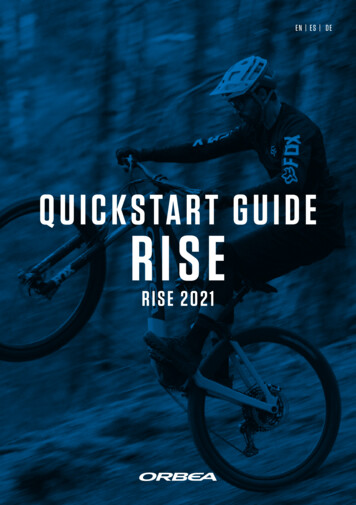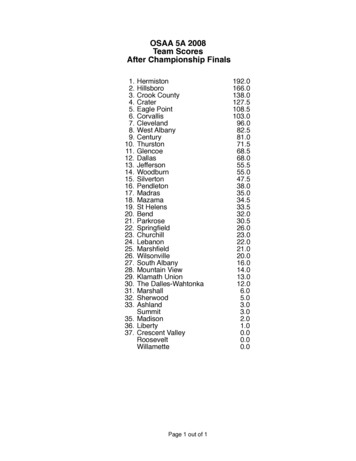
Transcription
The Rise and Fall of Wearable Fitness TrackersLynn CoorevitsiMinds-MICT-Ghent UniversityKorte Meer 7Ghent, BelgiumTanguy CoeneniMinds-SMIT-VUBPleinlaan 9Etterbeek, BelgiumAbstractWearables are becoming increasingly popular in different industries for various purposes. It issuggested that the market will reach 30 billion USD in 2020, containing a variety of productsmade by different companies. Yet one of the current issues is the large attrition rate ofconsumers no longer wearing their device. Current business models are built on technologypush and therefore do not succeed in matching the technology to consumer needs. Previousstudies have either focused on the technological features or adoption potential of wearables.Yet, little is known about the elements leading to attrition. Therefore the purpose of the paperis to identify the key determinants from a consumer perspective leading to dissatisfaction andeventually wearable attrition.Keywords: Wearable, Adoption, Attrition, TechnologyIntroductionMobile computing has evolved from devices that you can carry with you to technology thatcan be worn on the body, better known as wearable technology. It refers to garments oraccessories that are created and enhanced using electronics (King, 2011). Their appeal lies inthe information and entertainment they promise to potential users (Buenaflor & Kim, 2013).The available wearables provide various functionalities such as communication to a multitudeof devices and features such as a pedometer, heart rate monitor, etc. (McIntyre, 2014).Presented at AOM 20161
Compared to traditional mobile technology, they are perceived to be better at monitoring theuser and its surroundings (Svanberg, 2013) because they are designed to be unobtrusive andto blend well in everyday life (Casson, Yates, & Smith, 2010). The applications of wearabletechnology are increasing and popular in domains where they can serve specific goals. In thesecurity/safety sector, for example, functionalities such as remote monitoring are important,while in the wellness sector, the focus moves to functionalities such as sleep tracking. Manywearables have appealing characteristics, increasing the likelihood of broad consumeradoption: visual appeal, smooth integration with body and smartphone, feedback loops, easycustomization and relatively simple set up. In the near future they are expected to become animportant part of a user’s life (Karahanoglu & Erbug, 2011). Consequently, many companiesare developing and launching wearable devices, hoping to win market share in this verycompetitive consumer electronics market (Page, 2015).Wearable technology can be divided into two categories: wearable computers, whereelectronics are integrated in a fashion accessory such as bracelets or headphones, and smarttextiles, where the electronics are woven in the fabric (Page, 2015). This paper will focus onthe first type of wearables and more specifically activity trackers, because they arecommercially integrated in consumers’ everyday life (Rackspace, 2013).Although the potential of wearable electronics is expected to grow (Kipkebut & Busienei,2014), challenges continue to exist in effective long term use and adoption (Shih, Han, Poole,Rosson, & Carroll, 2015). While some of the users have positive attitudes towards these newproducts, some users may reject to use them for several reasons. First impressions, i.e. theperceived qualities, can trigger product adoption (Karahanoglu & Erbug, 2011) whileexperience will determine continued use (Shih et al., 2015). The key for companies fosteringadoption of wearables will lie in the efforts to understand the consumer’s adoption factors andmanage expectations accordingly to avoid dissatisfaction during use (Anderson & Lee, 2008).Presented at AOM 20162
Despite their popularity in the research community, little is known of how users perceive andinteract with these devices. Additionally, many devices have failed to become commerciallyviable (Hunn, 2015). This is not surprising, considering consumers often find theirexperiences with personal technology to be ambivalent. On the one hand they enjoy thebenefits of the technology, but on the other hand they get irritated by it (Johnson, Bardhi, &Dunn, 2008). Literature often focuses on positive drivers of technology use, such asperformance, ease of use, speed, and control, but does not sufficiently address the paradoxicalnature of consumer experiences with technology and the way it influences the consumer’sevaluation (Johnson et al., 2008). Nevertheless, understanding these negative experiences isvital as eventually they can lead to technology avoidance (Mick & Fournier, 1998). Think ofthe Google Glass and its recent failure. Initially, the glasses got hyped up, but Google was notable to bring the glass out of beta. Google overpromised certain features, creatingexpectations for its potential clients, which would eventually lead to disappointment. One ofthose promising features was the full-view overlay, while in reality there the information wasdisplayed in a small rectangle just above the eye. This made one of the main features, readingprofessional emails, difficult because the text was too small. Additionally the device wouldheat up very fast where the battery is located, on the side of the head, making it veryuncomfortable to wear. In other words, the expected benefits were not met, leading toabandonment of the device.A recent commercial study on activity trackers or fitness wearables showed that 30% ofconsumers stop wearing their device after 6 months and half the people who ever owned awearable stopped using it altogether (Endeavour partners 2014).Presented at AOM 20163
Figure 1: Declining Rate of Sustained Activity Tracker Use Ownership Adopted from Endavour Partners, September 2013Understanding the needs, experiences and evaluations of these ex-users can be an interestingsource of information, providing useful input to improve the innovation process (Schuurman,Mahr, & De Marez, 2012) so that it might lead to longer-term adoption of the technology. Inthe case of fitness wearables, it is important to understand the elements that led todissatisfaction and eventually avoidance of the device to improve consumer loyalty.Therefore, this paper provides some preliminary insights into how wearable technology couldbe improved from a consumers’ perspective by means of netnography, applied on Reddit.Technology Acceptance and AttritionExisting research often focuses on either the technical, use or adoption challenges related towearables (Choe, Leite, Seedah, & Caldas, 2014; Consolvo et al., 2008). Initial research wasmainly done by engineers, focusing on the technical challenges, while current researchacknowledges the importance of personal and contextual elements influencing the adoptionand use of the technology. This shows that research is slowly moving to a more user centereddesign approach. Rooksby, Rost, Morrison and Chalmers (2014) for example suggested thatresearch should pay more attention to personal preferences and individual characteristics. InPresented at AOM 20164
this work, we try to uncover use and adoption challenges that ultimately lead to attrition. Butto understand attrition, one must first understand the expectations that are present at the timeof adoption.Several theoretical models have been proposed to research the technology adoption process,but one of the most widely used models is the Technology Acceptance Model (TAM) (Davis1992), studying end-user acceptance of technology products (Venkatesh, 2000). TAM is anextension of the Theory of Reasoned Action originally developed by Davis (1989). It replacesthe attitude measures of Theory of Reasoned Action (Ajzen et al., 1980) with technologyacceptance measures, namely perceived ease of use and usefulness. Both theories assume thatif someone has an attitude towards behavior and they form an intention to act, they willeventually do so. The acceptance of the system is in other words determined by the intentionto use the system, which itself is influenced by the beliefs towards usefulness and ease of use.Perceived usefulness is the extent to which a user believes the system will enhance the user’sperformance, while perceived ease of use refers to the degree to which the user can use asystem free of effort (Lin, Shih, & Sher, 2007). Initially, the model was developed to apply inwork environments (Davis, 1989), but has proven its relevance in commercial environmentsas well (Lin et al. 2007).Commercial fitness wearables or activity trackers like Apple Watch, Fitbit, MyFitnessPal andJawbone are designed to support consumers in accomplishing a healthier level of physicalactivity. In other words, the perceived usefulness of activity trackers lies in supportingbehavioral change by wearing the device. For younger people, the appeal is to focus on fitnessoptimization, while older people are looking for improvement of their overall health and lifeextension (Endavour, 2014). According to Endavour (2014) several criteria are important vitytrackers:selectability/adoptability, design/aesthetics, out-of-box/setup experience, fit/comfort/formPresented at AOM 20165
factor, quality/robustness, user experience, API/Integrability, lifestyle compatibility andoverall utility. Selectability/adoptability refers to the uniqueness of the value proposition.Most users have no experience with these types of devices; making the selection processstressful because they do not know which one they should choose. Unique features can helpthem to choose a certain device Design and aesthetics are vital because the wearables arevisible to other people. The quality of the initial experience ( out-of-box/setup experience)should be pleasant and idealized. Also the fit and overall comfort of the device will be criticalto use the device for longer periods in time. This goes beyond the comfort of wearing thedevice, but is also related to the extent in which they intervene with daily behavior oractivities (e.g. typing). The wearable should also be of quality/robust and have a high degreeof resistance to wear and tear. The user experience should be intuitive and should transcendthe device, app, web services and overall support. One should be able to access the data viaother services (e.g. using an API) to enhance the user benefits and as such the overallexperience. Lifestyle compatibility refers to the change that the device requires in order tosimply wear it. The less change is required, the more likely it is to drive long-termengagement. Overall utility means that the device should be built around the goal they want toaccomplish and have a clear intent on how they will help the user (e.g. through habitformation). Nowadays activity trackers try to accomplish this by monitoring activity data suchas number of steps taken, distance traveled, speed and pace, calories burnt, heart rate, skintemperature, perspiration level, hours slept, dietary information, etc. This creates awarenessand allows users to observe their progress. But simply providing data to the user will not beenough: wearables also provide users with feedback in the form of information and/ornotifications tailored to their activity levels. Examples are the haptic feedback throughvibration of a bracelet when reaching 10.000 steps or the reminders sent to users to get up andPresented at AOM 20166
move when they have been sitting for too long. Another example is a possibility to comparethe accomplished results with others (Shih et al., 2015).Despite previous studies providing insights in what qualities activity trackers should have toimprove adoption and usage (Buenaflor & Kim, 2013; Karahanoglu & Erbug, 2011; Shih etal., 2015), the attrition rates of consumers that no longer use their device are high. This can beattributed to the fact that consumers often have ambivalent experiences with personaltechnology. The evaluation of those experiences is the result of whether the real experiencesmeet the initial beliefs about technology (Johnson et al., 2008). On the one hand they canenjoy the benefits of the technology, but on the other hand they can feel frustrated. As anexample, smartphones provide the benefits of constant connectedness to the outside andonline world, which can be a positive experience for consumers. However, this can also causeirritation, as it also means that they are never disconnected from work and their private andprofessional lives become intertwined. Another example can be found in the usage ofFacebook. A positive experience is the ability to stay in touch with long lost friends or peoplethat one does not see often anymore and stay updated on their lives with limited effort. As anegative experience, several studies have shown that the regular usage of Facebook can cause‘depressed’ feelings, as people feel their lives are less interesting or social compared to others.There is known to be a dynamic, ambivalent and paradoxical nature of consumer experiencesand the ways in which experiences influence the evaluation of the technology (Johnson et al.,2008). These experiences can undermine the satisfaction and eventually lead to attrition andor avoidance of the technology (Mick & Fournier, 1998). Failure to recognize theseexperiences can impact the marketing strategies and other efforts intended to create loyalty(Johnson et al., 2008).Oliver (1977, 1980) tried to explain this paradox by developing the expectationdisconfirmation theory, a cognitive theory which seeks to explain post-purchase or post-Presented at AOM 20167
adoption satisfaction as a function of expectations, perceived performance, anddisconfirmation of beliefs (Oliver, 1977, 1980). Expectations are the elements or attributesthat a person anticipates to find in the technology. They are the expectations related to theperceived usefulness and ease of use that lead to technology adoption in the TAM framework.Expectations influence the perception of performance and disconfirmation of beliefs. Prepurchase or adoption expectations will be compared against the final technology that is used.The perceived performance is influenced by these expectations and impacts the post-usagedisconfirmation of beliefs. The perceived performance is the perception of the actualperformance of the technology. The evaluation a person makes regarding the technology isthe construct disconfirmation of beliefs. These are made when the original expectations arecompared with the actual usage. If the balance is positive it will increase satisfaction, whenthe product underperforms compared to the initial beliefs, the person will be dissatisfied. Itcan be assumed that considering the limited focus on user needs in wearable researchdevelopment, the consumer beliefs of activity trackers got disconfirmed leading to avoidance.One study on wearables for example indicates that lifestyle compatibility, design/aesthetics,user experience and ability to integrate might provide challenges for long term behavioralchange with wearables (Shih et al., 2015). The data was gathered from an experiment set upin an academic context with students. Studies that focus on real life settings and attrition ofactivity trackers are missing, making the results of this research relevant for researchers andmanufacturers to improve upon existing technology, increase long term usage and consumerloyalty.MethodologyOur research data was collected via netnography (Kozinets, 2002, 2010), an online researchtechnique to gain consumer insights. The study was completed on Reddit content, a socialPresented at AOM 20168
networking, entertainment and news website developed in 2005 to which members of theonline community can submit content. People can vote the submissions up or down. Thesevotes are averaged in points and submissions and the higher points are put on top of the page.The content is organized by subdomains, also known as subreddits, which are visible on thefront page and include educational, entertainment, discussion based humor, image sharing,self-improvement, technology and meta themes. Members can post comments on submissionsby others.Netnography ( online etnography) is an interesting research approach asconsumers are increasingly relying on the Internet to make purchasing decisions and todiscuss purchased items. These online communities can have a substantial impact onconsumer behavior as their members exchange knowledge and their experiences with existingproducts (Füller, Matzler, & Hoppe, 2008; Jeppesen & Laursen, 2009). In other words, theycan provide rich insights for user research. Netnography is a way of capturing and analyzingthat data through digital communication. Methodologically, researchers can either choose toparticipate in the communication or refrain from doing so (Kozinets, 2002). In this research,we implemented a non-participatory form of netnography because another Redditer alreadyposted the question to which we studied the answers.The approach to netnography is: (1) making a cultural entrée; (2) collecting and analyzingdata; (3) ensuring trustworthy interpretation; and (4) following research ethics and providingopportunities for member feedback (Kozinets, 2002, 2010).In the first step, the entree, we identified a community that could be of relevance for theresearch question. In this case, we found a submission discussing “the attrition of wearablesafter 6 months”, asking Redditers why they stopped using theirs. Members of Reddit aredevoted, knowledgeable and innovative and their input can be of value to gather somepreliminary insights. Therefore, Reddit seemed a good community for this research,especially because the thread showed rich content, descriptiveness and conversationalPresented at AOM 20169
participation by different community members (Kozinets, 2002). If participants of an onlinecommunity are anonymous, the content is publicly available and not psychologically harmful,it can be assumed that their informed consent is implict (King, 1996). Nevertheless, thediscussion on ethical conduct is still going on and Kozinets (2002) suggests some ethicalconduct guidelines such as informing community members of the research and askingpermission to quote. We followed the guidelines of Kozinets (2002) in this research to assureno ethical boundaries were crossed.Data was directly copied from the community platform and analyzed through open coding.This is the process of breaking down, examining, comparing, conceptualizing andcategorizing data (Strauss & Corbin, 1998). In December 2015, we identified 153 commentson the question ‘Why’d you STOP using your fitness wearable device?’. The data wasgathered over a period of 4 weeks on Reddit. After 3 weeks, members’ activity nearly stoppedand therefore on week 4 we decided to discontinue the data gathering process. The data ofeach category was compared to other data belonging to the same category, inquiring into theirsimilarities and differences. Each category formed a theme or meta-observation. Thecategories of data were interpreted through content analysis. Although classification andcoding are a tradeoff for symbolic richness, netnography can take advantage of the contextualrichness. Netnography is based on the observation of the textual discourse rather than theobserved behavior that occurs in ethnography (Kozinets, 2002). To create trustworthyinterpretations, we determined the importance of the answers in relation to the researchquestion. Of the 153 comments, 54 were irrelevant for the analysis because the person waseither still wearing the activity tracker or they were off topic. When not taking the irrelevantcomments into consideration, only 3 people answered more than once in the community, yetdid not answer more than twice. This shows no vocational extremists were taking over theconversation. One researcher analyzed the input of 93 unique and relevant participants.Presented at AOM 201610
ResultsThe different categories of the analysis were linked to the expectations leading to adoptionand usage of fitness wearables mentioned in previous Endeavour research (cfr supra). For onecategory, we were not able to do this, because there was no link to the expectations, namelyfor those people who mentioned that they lost their device. The mentions in figure 2 refer tothe amount of times community members communicated that their expectations were notbeing met, leading to attrition. The points in figure 2 are an average number of upvotes anddownvotes, calculated by Reddit. This can be interpreted as the average amount of people thatagreed with a comment and were added to the relevant categories. Because there are nodeeper insights on the amount of people that upvoted and downvoted per comment, the pointswere merely added to the category and no other calculations were performed.Figure 2, resulting from the in-depth analysis, shows that the main dissatisfaction can beattributed to wearables that don’t fulfill the expectations on the fit/comfort/form factor,selectability/adoptability and overall utility. More specifically, respondents feel thatwearables often inhibit their current performance, that the added value in terms of metrics istoo limited and that the accuracy of the data is too small to improve their behavior.Additionally, the overall user experience can be improved as well. Manufacturers can learnfrom this research by optimizing the innovations to match user needs better and marketers canlearn to manage expectations based on the link between the optimized product and the userneeds.Presented at AOM 201611
# MenGoned156827 85 95 64 73 84 62 6LostFit/Comfort/FormFactor- AllergyOverall UGlity RedundancyOverall UGlity - Limiteddata ifestyle CompaGbility Easy to forget2022Lifestyle CompaGbility ChargingOverall UGlity Accuracy / Reliability4SelecGon/Adoptability alternaGvesSelectability/Adoptability - Limited758Overall UGlity - SocialComparison19User Experience23Fit/Comfort/FormFactor - awareness/7716Points Sum percategoryQuality/Robustness104Figure 2: Overview results netnography linked to expectationsFit/Comfort/Form Factor - Awareness/Inhibiting performanceAlthough wearables have the intention of being unobtrusive, some consumers still complainthat they are not and stop wearing the device because of this. This category consists of twocomponents: psychological and physical awareness. Psychologically, the wearables can makeusers so obsessed about the device that they no longer enjoy wearing it. Obsession can displayitself for example in distraction from daily activities as they keep on checking their phone forprogress. For some users it even inhibits their sleep because they are so focused on wanting tosleep well. Additionally, it can make them feel bad if they do not reach the predeterminedgoals. Physically, the device can get in the way of exercising, especially when lifting weightsor in daily behavior, when the clasp gets stuck to their clothes. Additionally, some wearablesare not worn on the wrist but under clothes, which is perceived as uncomfortable.The following quotes are indicative of the type of data that was subsumed under this category.“I actually bought mine mainly for sleep tracking but found that I was actually concernedabout quality of sleep so much before I went to bed that it was impacting my sleep negatively.Started sleeping better again as soon as I stopped wearing it.”Presented at AOM 201612
“The clasp on mine drove me crazy. It caught on everything and would undo itself all thetime.“Selectability/Adoptability - Limited MetricsThis theme handles the limited metrics currently provided by fitness wearables. Most activitytrackers provide consumers with a step counter and time. Wearables were initially marketedtowards the ‘fit’ people allowing them to track their progress. They initially bought the devicefor this purpose but soon realized that the functionalities are too limited. When liftingweights, cycling, etc. it will not provide them with sufficient insights in their workout.Because of these limited insights, they stopped wearing their device. Additionally,functionalities such as heart rate measurements and accelerometers are not optimized forworkouts. The current metrics are perceived as ineffective (such as step count) to deduceinteresting insights from the data relevant to the workout.The following quotes are indicative of the type of data that was subsumed under this category.“The more niche the application of the device, the more likely it will be used to trackimportant metrics. I'm a cyclist and a Fitbit owner and as soon as I got a Garmin Edge with aHR monitor to track my rides it just made the Fitbit obsolete. Steps per day isn't an importantmetric for me to base my fitness on any more.”“My Charge HR got sweat under the screen after about two months, killing it. I reported theproblem and Fitbit quickly gave me a replacement.which then broke again within weeks. Idon't think it's worth my time even to ask for another one. As everyone else has mentioned, theFitbit is optimized as a step counter; it's not much good for biking or weight lifting, my mainexercises.”Overall Utility - Accuracy/ReliabilityPresented at AOM 201613
The accuracy and reliability of the data can be attributed to the sensors not picking up theright information and not being able to correct for confounding factors. This is for examplethe case when step counts are being added while standing or sleep is tracked while beingawake. Some consumers also mentioned that contextual factors such as sleeping in a differentbed could influence the registered data, making its interpretations less reliable.Consumers within this category stopped wearing their device because they noticed adiscrepancy between their behavior and the registered data, which made them lose faith in theoverall value of the data.“After wearing my Fitbit HR for a few months I developed a really good sense for my dailystep count, to the point I could accurately estimate it without actually wearing the tracker.Not to within a dozen steps or anything like that, but I can definitely tell when I've done my10k or not. I also found the heart rate monitor insufficient for work outs and so I still had toresort to a stand alone chest strap model. And the sleep accuracy wasn't accurate enough tojustify wearing it just for that. The only thing I really miss about it is the "steps" counter.Thought it was pretty cool to know about how many "steps" I climbed from day to daybecause I live in the mountains.”“I got mine to track sleep, and quit bothering when I discovered it thought I was in deep sleepeven when I was just lying still but awake.”User ExperienceUser Experience refers to the ease of use in tracking and gathering data. In the beginning,most wearables required to be set up when tracking sleep. But the majority of users forgot tochange their settings, making the data irrelevant. Additionally, overall health tracking requiresPresented at AOM 201614
too much effort from the user. If they want to track how healthy they are by counting caloriescombined with their activity level, the applications require too much effort because they haveto input their activity manually through the application.“Ha, my issue was I kept forgetting to activate the sleep mode on my Jawbone.ended upselling it online to someone else”“Its a pain to set up every night. And when you sleep on different beds with different firmnessthe data is not reliable.”Overall Utility – Social ComparisonSocial comparison and status is often mentioned in research as one of the reasons to adopt awearable device. Projecting the image of being a healthy person can motivate consumers toadopt the device. Yet, it can also be a reason to avoid the device after a while, as other typesof consumers one does not want to be associated with, are starting to adopt the device.Additionally, not being able to compare your results with others that have a wearable can be areason to stop using the device.“Nailed it. Steps is such a bullshit metric. And it kills me inside when people are like "Howmany steps do you have today?!?!", and I'm like "6500". And they are like, "OH! I'M AT7000! I'M WINNING! Guess I can have another donut!" . But my 6500 doesn't include the45 mins on an exercise bike, and 45 mins of lifting while on a 2200 cal/day diet. Don't get mewrong, it's a great way to encourage people who tend to be idle, but in no way shape or formis it a proper barometer of overall health and activity. So, I stopped wearing mine, so peoplewould stop asking me.”Quality/RobustnessPresented at AOM 201615
Within this category, issues with Fitbit devices were mentioned the most, but other wearablebrands like Nike or Jawbone also broke down on the user. This was the case both for physicalelements and technical features. Many users experienced issues with the straps of the devicesbreaking or wearing out. Additionally, some technical elements caused the device to stopworking, like synchronization issues, inability to download or update the application orfunctionalities that stopped working correctly.“Because I got tired of my Fitbit Flex bands fucking breaking at the window all the time.Also, having to reset the thing because it won't sync after a run sucks, you lose all yoursteps.”“Because it quit working properly (Nike Fuelband). It wouldn't charge well anymore andwouldn't connect to the PC I want the new windows one though”Selectability/Adoptability - AlternativesWearables are easy to replace by alternative devices such as smartphones that providefeatures such as step counting, sleep tracking, etc. or better devices that supersede thefunctionalities of the previous device. For some devices, the added value and USP is toolimited giving for example users that stopped using their wearable because of the limitedmetrics, a r
made by different companies. Yet one of the current issues is the large attrition rate of . nature of consumer experiences with technology and the way it influences the consumer's evaluation (Johnson et al., 2008). Nevertheless, understanding these negative experiences is . This shows that research is slowly moving to a more user centered .











